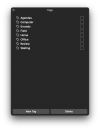I love this topic so much and I feel your pain
@christophe.portier. As a fully remote employee, nearly everything I do at work -- and at home for that matter -- requires a computer to get it done. Email, design work, writing courses, online purchases, reading articles or company communications, paying rent, researching a new idea, planning a trip... most technically happen on a computer. So how do you keep your @Computer list from becoming a wooly mammoth? What's been working well for me is changing the way I think about each context and the types of actions that fall under them, rather than changing the contexts themselves. As someone who likes to my system lean and mean, here's what's been working for me:
@Admin: Little life/work management tasks -- pay a bill, schedule a Zoom meeting, reorganize OneDrive, update Safari bookmarks, sign a PDF form, book a flight... Yes, many of these will happen at a computer (or iPad) but they're typically short and don't require much cognitive heavy-lifting. They're more about keeping life and work "up & running."
@Agendas: ALL my communications with colleagues, friends and family. Whether it'll ultimately be an email, phone call, MS Teams chat, 1:1 meeting topic, SMS, social media DM... if it's something I need to discuss with another human it goes under @Agendas.
@Computer: tasks that require me to be not just physically at my computer but fully present in "doing computer work" mode. Examples include building a PowerPoint deck, writing a course syllabus, designing an infographic, creating a home inventory spreadsheet, creating an itinerary for a trip to Rome... These are the longer, more cognitive-heavy (and processor-heavy) tasks that require a computer to get done (versus the shorter, simpler @Admin examples above that I can often bang out on my iPhone, iPad, whatever...).
@Errands: anything that requires my physically leaving the apartment (pick up dry cleaning, buy a book at Shakespeare & Co...)
@Home: anything that requires my being physically in my apartment (cleaning, organizing, installing, repairing, etc.). The @Home context is different from my Home
area which includes any and all NA's relating to my home environment (i.e. an errand to pick up ingredients for dinner; and admin task to research new internet providers...)
@Office: this one gets a little tricky but I try to reserve this context for things I need to do when I'm in my home office environment, such as "rehearse facilitating material for new training course." While my computer is typically involved, it's less about doing "computer work" and more about being in office mode (for example, I wouldn't rehearse a workshop if I happen to be working from Starbucks). I don't use this too often but it helps for those work tasks that don't naturally comply with my definition of @admin or @computer.
@Purchases: anything I need to, intend to, or am considering buying whether online or in-person. Typically reserved for larger or discretionary purchases so I can compare all the things I plan to spend my money on and (hopefully) make an informed decision. It's also a way for me to incubate those nasty impulse purchases for a few days. (Small necessities like regular household items don't go here -- those will either become an errand or an admin item to pick up or order...)
@Read/Review: probably my favorite context. All the company communications, articles, newsletters, blogs, etc that I need or intend to read. Most of these, of course, are digital and I'll read them at my computer but this context helps separate them for when I'm in "reading mode."
And that's a wrap. Hope some of these help you out, too!

